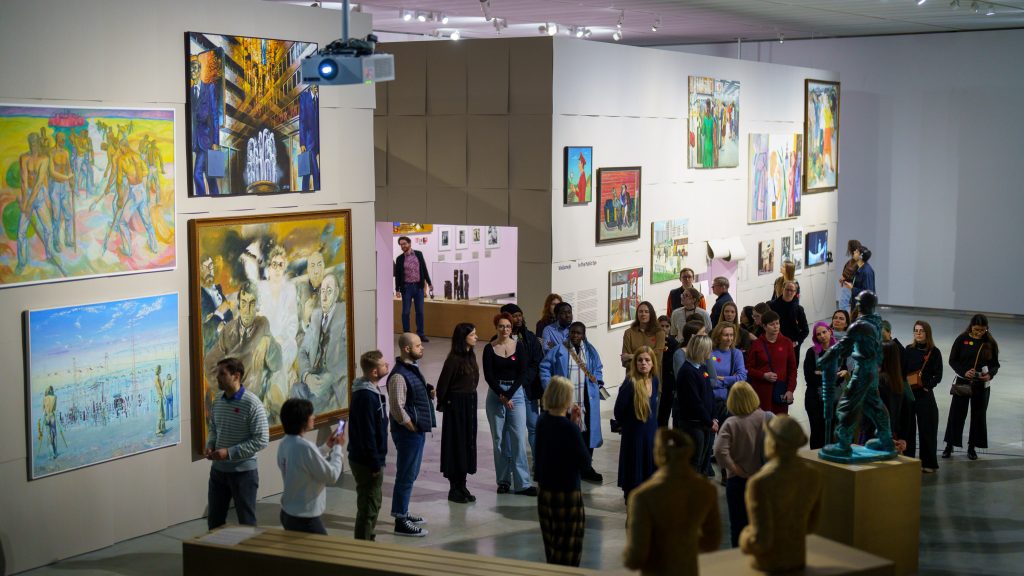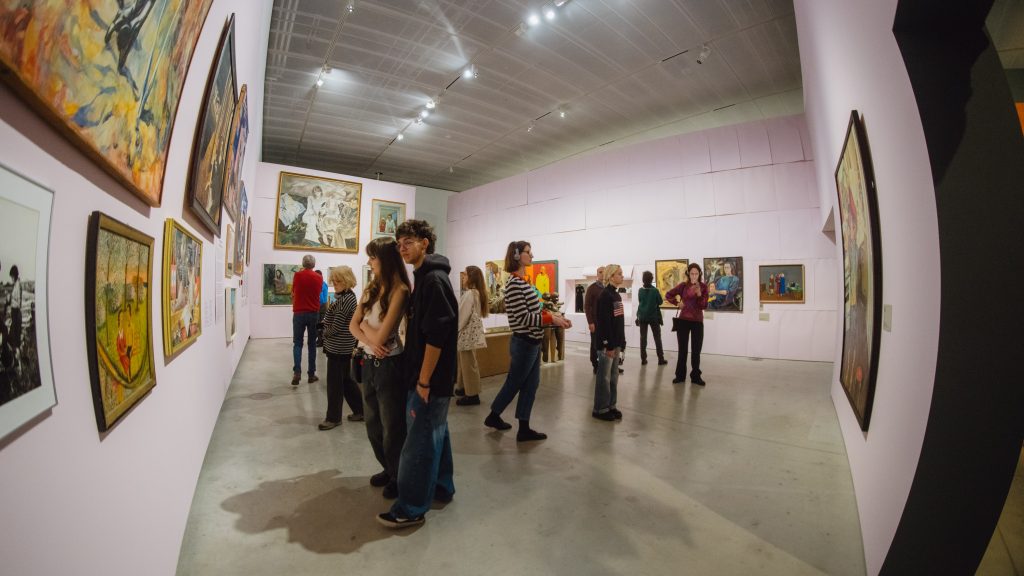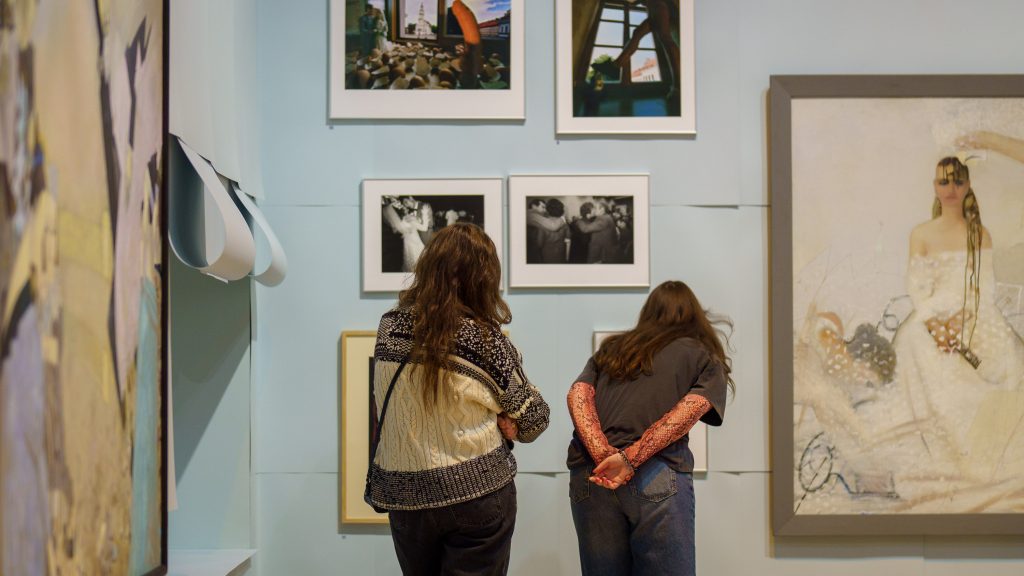We Don’t Do This

During the long decades of Soviet occupation, sexuality-related content and discussion were widely censored from the public. According to a famous catchphrase, there was no sex in the USSR. We ask why was sex so suppressed and what kind of love was allowed? How different are the region’s public notions of intimacy, gender, love and sexuality today? We Don’t Do This. Intimacy, Norms and Fantasies in Baltic Art will explore the shifts and changes in representations of gender, family and sexuality, marked by back-and-forth loosening and re-enforcement of norms throughout the Soviet era and beyond.
IMPORTANT! Major exhibition WE DON’T DO THIS contains nudity. Minors are allowed entry when accompanied by an adult.


More about the exhibition
Sexuality is a central part of human life, as are desires, fantasies, gender, and the relationships we form. No less widespread is the wish to impose control over these facets of life. Bringing together a diverse range of works drawn from museum and private collections, as well as new commissions, We Don’t Do This. Intimacy, Norms, and Fantasies in Baltic Art focuses on gender representations and relations in visual art of the Baltic region from the 1960s until the present.
The exhibition borrows its title from an eponymously titled drawing by Česlovas Lukenskas from 1984 – Šito pas mus nėra. Lukenskas’ statement anticipated the famous 1986 tele-bridge between the USSR and the United States, where a woman on the Soviet side remarked that there was no sex in Soviet TV commercials. Since Stalin, the USSR was famously anti-sexual: Sexuality-related content and discussions were widely censored from the public for many decades. We ask why sex was so suppressed and what kind of love was allowed. Through new research in Baltic art collections, re-interpretations of art historical narratives, and by following recent academic writing on sexual culture in the Baltics, this exhibition explores how different the region’s public notions of intimacy, gender, love, and sexuality are today. How much are we still under the spell of the dreams of the Soviet period and how have national aims changed over time?


Chronologically, the exhibition begins with the Khrushchevian “Thaw”, picking up echoes from the ultra-conservative Stalinist period. It highlights the aestheticized nudes and lofty representations of romance in the 1960s and 1970s, the freeing and hyper-normative trends of the 1990s and 2000s, and the critical interventions of artists working today. Examining figuration in painting, sculpture, drawing, among other media, We Don’t Do This revisits canonical artworks, engaging them in unexpected and playful dialogues with lesser-known works from different generations and countries. A number of them resist the pressures of their era, with artists diverging from the visuality of official discourses and an inherited patriarchal imagination. Arranging works in thematic clusters, the exhibition presents an array of both intimate, and normative representations or fantasies of gender, family, and sexuality, marked by the back-and-forth loosening and re-enforcement of norms throughout the Soviet era and beyond.
We Don’t Do This suggests that the fight for political liberty did not always automatically result in social and sexual freedoms of equal rights to pleasure, safety, and love. Queerness, which lives in everyday realities, on the streets and in social media, as well as in new scholarship in gender studies, supports a critical look at the heteronormativity of the Soviet past as well as of the neoliberal present. New commissions by contemporary artists Kadi Estland, Saša Kochan, Janina Sabaliauskaitė, and Konstantin Zhukov suggest that today there is more space for resistance and deviation from social conventions than during any period in the past. If we were to rethink the exhibition’s catchphrase, perhaps it prompts us to ask how we could be intimate, fantasize, and form relationships differently?
Exhibition team
Curators
Inga Lāce, Adomas Narkevičius, Rebeka Põldsam
Architects
Laura Linsi, Roland Reemaa
Graphic designer
Monika Janulevičiūtė
Coordinators
Marius Armonas, Kamilė Jagėlienė
Technician
Dominykas Šavelis
Research assistants
Diāna Lauriņa, Saule Ziziliauskas
Lenders of the artworks
Artūras Barysas-Baras family, Bruno Birmanis, Matas Čuplinskas, Laimutė Drazdauskaitė, Milda Drazdauskaitė family, Art Museum of Estonia, Kupiškis Ethnographic Museum, Museum of Artists’ Union of Latvia, Latvian National Museum of Art, Latvian Centre for Contemporary Art, Lithuanian Photographers Association, Lithuanian Special Archives, Lithuanian Art Centre Tartle, Lithuanian National Museum of Art, Zuzeum Art Centre, M. K. Čiurlionis National Museum of Art, Violeta and Romanas Raulynaitis, Mindaugas Ruseckas, Miglė Šontaitė-Petkevičienė, Tartu Art Museum, University of Tartu Museum, Alise Tīfentāle and the “Art Days Forever archive”, Teodoras Kazimieras Valaitis family, Silvija Voite, Museum of the Vilnius Academy of Arts.
Artists
Peeter Allik (1966–2019), Valentinas Antanavičius (1936), Robertas Antinis (1898–1981), Arnis Balčus (1978), Artūras Barysas-Baras (1954–2005), Biruta Baumane (1922–2017), Auseklis Baušķenieks (1910–2007), Bruno Birmanis (1962), Robyn Beeche (1945–2015), Boriss Bērziņš (1930–2002), Māra Brašmane (1944), Rasma Bruzīte (1919–2001), Violeta Bubelytė (1956), Jānis Buls (1959), Vytautas Ciplijauskas (1927–2019), Adomas Danusevičius (1984), Arūnas Daujotas (1963–2012), Biruta Delle (1944), Kostas Dereškevičius (1937–2023), Milda Drazdauskaitė (1951–2019), Rudīte Dreimane (1948), Zenta Dzividzinska (1944–2011), Laima Eglīte (1945), Silva Eher (1954–2021), Ance Eikena (1997), Albert Eskel (1922–1975), Juta Eskel (1927–2017), Kadi Estland (1973), Merike Estna (1980), Mudīte Gaiševska (1935), Vincentas Gečas (1931–2020), Ugnius Gelguda (1977), Vladimirs Glušenkovs (1948–2009), Andris Grinbergs (1946), Aušra Griškonytė-Volungė (1976), Pranas Griušys (1955), Antanas Gudaitis (1904–1989), Helēna Heinrihsone (1948), Atis Ieviņš (1946), Ieva Iltnere (1957), Edgars Iltners (1925–1983), Kristina Inčiūraitė (1974), Gunārs Janaitis (1934–2022), Evaldas Jansas (1969), Silvia Jõgever (1924–2005), Agnė Jokšė (1993), Arūnas Jonikas (1963), Aija Jurjāne (1944–2015), Marija Danutė Jukniūtė-Bžeskienė (1943–2023), Džiugas Jurkūnas (1972), Elvyra Kairiūkštytė (1950), Vladas Karatajus (1925–2014), Kaja Kärner (1920–1998), Miljard Kilk (1957), Liisbeth Kirss (1996), Elena Kniūkštaitė (1950), Saša Kochan (1998), Epp Maria Kokamägi (1959), Gleb Kosorukov, Jurij Kozyrev (1963), Jānis Kreicbergs (1939–2011), Blažiejus Krivickas (1908–1988), Ilmar Kruusamäe (1957), Aime Kuulbusch-Mölder (1942), Toomas Kuusing (1976), Loreta Lapienytė (1959), Maria Izabella Lehtsaar (1998), Ly Lestberg (1965), Dace Lielā (1957), Aivars Liepiņš (1953), Vitas Luckus (1943–1987), Chintis Lundgren (1981), Aleksandras Macijauskas (1938), Jūratė Macnoriūtė (1953), Gintaras Makarevičius (1965), Ilmar Malin (1924–1994), Olav Männi (1925–1980), Antanas Martinaitis (1939–1986), Petras Mazūras (1949), Snieguolė Michelkevičiūtė (1953), Antanas Miežanskas (1938–2017), Šarūnas Milkevičius, Visvaldas Morkevičius (1990), Rauno Thomas Moss (1977), Leili Muuga (1922–2016), Nancy Nakamura Rap Unit / liina pääsuke (1990), Katrīna Neiburga (1978), Valerija Ostrauskienė (1927–1997), Ülo Õun (1940–1988), Tiit Pääsuke (1941), Jaan Paavle (1940–2010), Vytautas Palaima (1911–1976), Jüri Palm (1937–2022), Felicita Pauļuka (1925–2014), Uldis Pāže (1950), Igoris Piekuras (1935–2006), Agu Pilt (1951–2002), Varmo Pirk (1913–1980), Ivars Poikāns (1952), Enn Põldroos (1933), Miervaldis Polis (1948), Eglė Rakauskaitė (1967), Romualdas Rakauskas (1941–2019), William Rötttger (1948–2015), Marija Teresė Rožanskaitė (1933–2007), Sirje Runge (1950), Janina Sabaliauskaitė (1991), Edmundas Saladžius (1950), Arvydas Šaltenis (1944), Lembit Sarapuu (1930), Haroldas Šatūnas (1967), Šarūnas Sauka (1958), Ludmilla Siim (1938), Mindaugas Skudutis (1948), Džemma Skulme (1925–2019), Virgilijus Šonta (1952–1992), Julijonas Algimantas Stankevičius-Stankus (1933–1998), Laura Stasiulytė (1977), Henry Stein (1957), Sandra Straukaitė (1970), Vaclovas Straukas (1923–2017), Olev Subbi (1930–2013), Maija Tabaka (1939), Aino Tõnisson (1932–1996), Jaan Toomik (1961), Mare Tralla (1967), Anna-Stina Treumund (1982–2017), Antanas Tučius (1902–2000), Gediminas ir Nomeda Urbonai (1966, 1968), Teodoras Kazimieras Valaitis (1934–1974), Lüüdia Vallimäe-Mark (1925–2004), Povilas Ričardas Vaitiekūnas (1940), Sofija Veiverytė (1926–2009), Envija Vernere (1990), Edgar Viies (1931–2006), Nijolė Vrubliauskaitė-Liutkevičienė (1950–2021), Aija Zariņa (1954), Konstantin Zhukov (1990), Kazimiera Zimblytė (1933–1999)
Major Partners



Information Partners





Institutional Partners


Exhibition Partner
